

The island nation of Grenada lies in the Caribbean Sea and is a part of the Antilles archipelago. It consists of several small landmasses apart from the two major ones, the Carriacou and Petite Martinique. Close to Venezuela, Trinidad and Tobago, the islands have an advantageous geographical location for boosting tourism.
They are also known as the ‘Island of Spice’ as nutmeg and mace crops comprise a significant part of exports. Grenada also ships bananas, cocoa, fruits and vegetables, chocolate and seafood. Tourism drives the economy and is centred on the development of cruise ports, waterfronts, beaches, carnivals and festivities.
Let us have a look at the major ports of Grenada.
St George’s is the largest and the busiest port in Grenada. The harbour lies on the southwestern coast, close to the Windward Islands of the eastern Caribbean. It is divided into two operational areas; one for cruise vessels and the other for cargo operations. The inner harbour comprises two basins, leading to the commercial port and the pleasure craft piers.
The facility deals with a variety of cargo such as asphalt, sugar, grains, LPG products, refrigerated cargo, fertilisers, tropical fruits, cocoa, packed foodstuff etc. A repair workshop at the eastern part of the island caters to yachts and small passenger vessels.
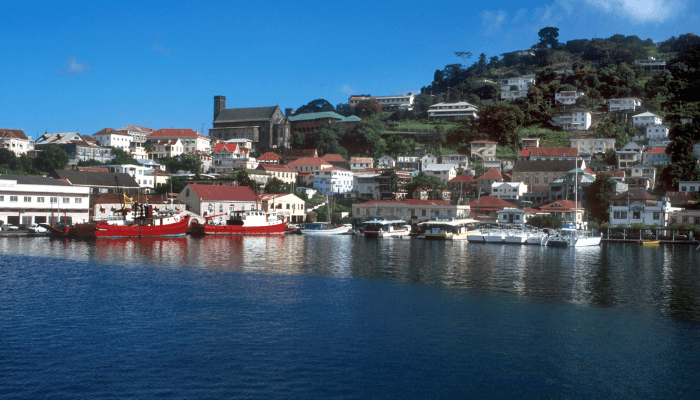

Approximately 1650 ships, 530,000 tonnes of cargo, 19,000 TEUs and over 260,000 passengers are handled at the port annually. Ships with a maximum LOA of 310 metres and a draught of 10.5 m can enter St George’s port.
In the 1970s, the port of St George’s experienced rapid growth in shipping traffic. Hence, by the 1980s, port expansion programs commenced. Cargo terminals in Grenada were refurbished and expanded to accommodate the increased throughput.
Today, the harbour is equipped with the latest equipment and automated systems for convenient port operations. Most importantly, the Grenada Ports Authority has shifted the cargo handling berths to the Carenage or the North Basin, while a new cruise centre has come up on the western coast for promoting tourism. This plan is a part of an important tourism project which aims to transform the Melville region into a popular cruise destination.
The new cargo wharves were expanded on the eastern side and land was reclaimed for building extensive storage areas and parking spaces.
St George’s port recorded an increase in cargo volumes every year. However, the port recorded a ten per cent decrease in total annual throughput in 2004, owing to the Ivan Hurricane which wreaked havoc on the island nation. It impacted the export of bananas and nutmeg while imports of raw material, construction equipment and machinery also fell considerably.
The ISPS Code was implemented at St George’s in the same year, which drastically improved the port’s security and attracted many international businesses and potential investors. From 2006 onwards, the port started operating at its optimum capacity.
Since 2010, container traffic has increased in leaps and bounds. Today, it comprises roughly 45 per cent of the total cargo throughput.
The cargo port lies in the Carenage basin and consists of a 335 m long berth with water depths ranging between 8 to 9.1 metres and a height of 2.6 m. It was expanded in 2001 and offers 35,000 square feet of open storage space and six acres of container stacking areas.
At the end of this berth lies an 82.5 m long and 5 m deep schooner berth, which caters to inter-island ferries. A 9,800 square ft warehouse is adjacent to this wharf. Also, a different exit gate is used by ferries for allowing a speedy departure from the port.
A tanker terminal lies at the Grand Mal Bay and the Queen’s Park harbour. The newly built cruise terminal lies in the Lagoon basin and contains two passenger berths. The northern wharf spans 375 metres with a depth of 10 m while the southern berth is 360 metres, having an alongside depth of 11 m.
A wide range of equipment is owned by the cargo terminal including 15 fork-lift trucks weighing one to six tons, 5 tractor-trailers, 2 reach stackers with a lifting capacity of 40 and 45 tonnes and a 35-tonne top-lifter. The port authority plans to acquire a 100-tonne mobile crane as well.
The port has several storage areas and the free storage duration for general cargo is 5 working days, starting from the date of cargo arrival at the port. It is 2 weeks for RORO and 20 days for LOLO containers.
Transit shed 1 covers 20,000 sq ft for storing general cargo. The Queens shed and CARICOM warehouse measure 22,000 sq ft and are used for keeping construction material and machinery. Two open yards are used for keeping raw material. The freight station has 25 reefer connections for refrigerated cargo.
Grenada Port authority prohibits ships from carrying organic waste into the port facility. All such waste should be dumped at least 13 nautical miles offshore. Onshore facilities for discarding non-organic, recyclable waste are chargeable. The port berths have provisions for electricity, fresh water and refuelling.
Also known as the Lance Aux Epines port, Prickly bay harbour is located on the southern shoreline of Grenada. It is an entry point for yachts and extends from the Prickly point to the Mace or true blue point. Yachts are advised to enter with caution since the navigation channel is lined with reefs. Anchorage is allowed inside the port in depths of 6 to 14.5 m.
Spice Island Marine Service Corporation Limited operates the Marina. Prickly Bay has been a famous yachting destination for half a century. Its picturesque waterfront and calm waters provide a perfect relaxing getaway and an enjoyable trip.
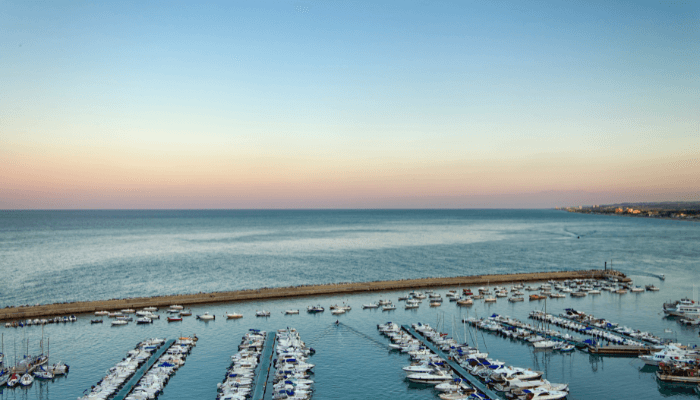

The modern marina has chandlery, laundry, a shopping complex, restrooms and a fully air-conditioned lounge. Many exciting excursions are offered at the facility. One can opt for scuba diving and explore the age-old wrecks of ships or enjoy fishing, water-skiing and sailing.
The marina is just 15 minutes from St George’s town and a few kilometres from the international airport. There are many things to see and explore such as the mediaeval forts, the spice market, the seafood stalls, wine factories, chocolate shops and so on.
Nature lovers must visit the Grand Etang National Park. It has over 20 animal species and a 30-acre lake, lying 1640 m above sea level near a dormant volcano crater.
The second biggest town of Grenada, Grenville is also the capital of St Andrew Parish. It lies on the eastern coast of the Caribbean island. Grenville has an agriculture intensive economy and cash crops, tropical fruits and vegetables are produced for export. A close-knit community, Grenville has three high education institutions, an elementary school and an Anglican Church for its 3000 residents.
The waters of the Grenville port extend from Telescope point to the Soubise Point. The Marquis Islet distinguishes St Andrew’s bay from Grenville bay. One should navigate into the harbour carefully, as there might be pretty strong north-eastern winds.


Grenville has a 234 m long pier with a depth of 3.5 metres. Vessels can anchor in the outer reef region; pilotage is mandatory for vessels more than 150 grt.
The port serves fishing vessels and small cargo ships. It functions as the transportation and financial centre for the eastern part of the island. Grenville once possessed the largest nutmeg processing unit in Grenada, however, it was closed in the 1990s. Today, the port is a vital part of the city. Adjacent to the cargo pier is a market, organised every weekend with locals selling handicrafts, dairy and agro-based products.
A pleasure port, the Tyrrel bay Marina is located in the southwestern end of Carriacou, Grenada. Boats and Yachts can anchor in the northern part of the outer bay as the inner bay is not suitable for the same. Pilotage is compulsory for vessels weighing over 200 gross tonnes.
The marina has a 500 feet long S dock that spans from the east to the west, allowing yachts to anchor in depths ranging from 16.5 to 18 feet. These docks are made of sturdy concrete blocks and steel reinforcements held up in a place with sand screws. The docks are five-metre wide and have plentiful space to move around.
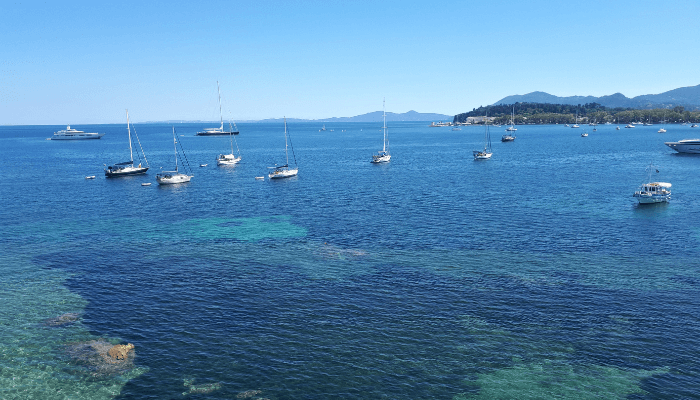

Apart from the main dock, there is a 180 feet long and 3.5 m wide finger pier B running to the north. It has a depth of 16 ft and has anchorage space for more than 20 ships.
Both the facilities can accommodate 200 ships and also contain a repair yard. Services like pressure washing, bottom scraping, cleaning, painting, welding and general repairs are offered.
The marina has a 150-tonne travel lift which can lift boats with a 32 feet beam, 18 ft draft, measuring 130 ft lengthwise. It also has a 30-tonne shore crane for engine and mast lifts and a man lift as well.
Hillsborough is the biggest settlement on Carriacou in Grenada, serving as a major tourist hub and commercial centre. It is a peaceful city hosting annual regattas and carnivals, attended by thousands of tourists. The town flaunts historical architecture, brightly coloured houses and white sandy beaches. Ferries ply from this city to the nearby island of Petite Martinique. The Lauriston airport is just two kilometres from the main town.
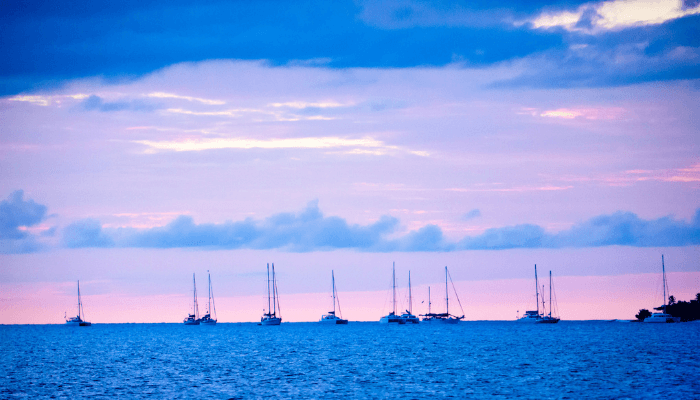

The entrance channel lies between the Jack-a-Dan and the Sandy Islet. The harbour consists of an open pier which receives yachts, passenger boats and ferries.
St David’s Harbour is located on the southern coast and stretches from Little Bacolet point to St David’s point. The navigation channel is lined with buoys and the harbour is restricted to yachts. Natural reefs and a peninsula enclose the harbour from both sides, making it safe. The hills around the bay are lined with almond and palm trees. Close to the port is a beach and a resort hotel.
There is no main town near the harbour, however, the Grenada Marine boatyard has a general store, a bar, a chandlery and a souvenir shop. The boatyard can accommodate around 100 yachts and has travel lifts and hurricane storage facilities.
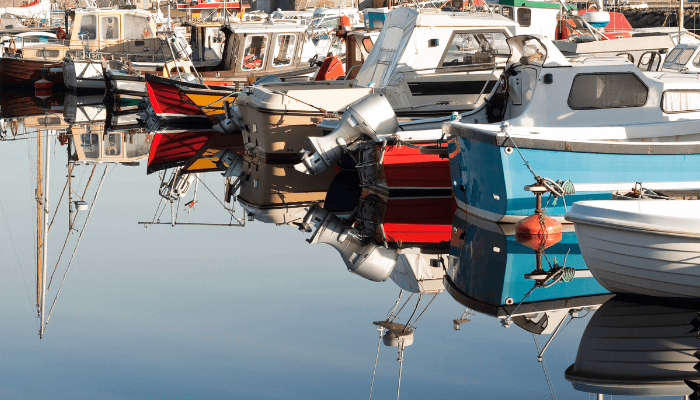

St. George’s is the nearest town, around 45 minutes from St David’s harbour. The latter has a bus terminal and car rental booths.
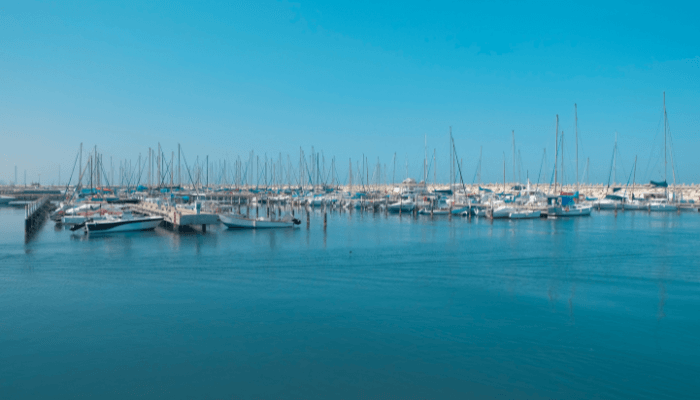

Lying on the southern coast of Grenada, the Le Phare Bleu Marina contains an E-shaped dock with three-finger piers. It has 60 berths for yachts measuring 100 ft lengthwise, with a draft of 15 ft. The buoyed navigation channel leads to the luxurious marina offering numerous amenities such as restaurants, bars, seaside suites with swimming pools and much more. One can enjoy camping, live music and water sports like kayaking, paddle boarding and surfing. The marina has a bakery, a hair salon and a special Asian spa.
Disclaimer: The authors’ views expressed in this article do not necessarily reflect the views of The Marine Learners. Data and charts, if used, in the article have been sourced from available information and have not been authenticated by any statutory authority. The author and The Marine Learners do not claim it to be accurate nor accept any responsibility for the same. The views constitute only the opinions and do not constitute any guidelines or recommendations on any course of action to be followed by the reader.
The article or images cannot be reproduced, copied, shared or used in any form without the permission of the author and The Marine Learners.










We believe that knowledge is power, and we’re committed to empowering our readers with the information and resources they need to succeed in the merchant navy industry.
Whether you’re looking for advice on career planning, news and analysis, or just want to connect with other aspiring merchant navy applicants, The Marine Learners is the place to be.